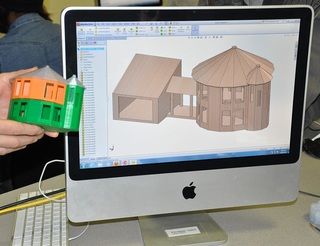First-year students in the engineering program at Penn State Greater Allegheny are experiencing a fun new way of learning. The campus recently purchased a 3-D printer with funds from a grant called Toys ?N More, which is a National Science Foundation program aimed at increasing the retention of engineering students.
Many students start in an engineering program in college only to leave due to difficulty in math and science classes. The Toys ?N More program uses toys to help get students excited about what engineers do in hopes of motivating students to work harder in their math and science classes. The program is imbedded in a course most engineering students take in their first year at Penn State.
Introduction to Engineering Design teaches basic design methods, while getting students comfortable working in teams, teaching them computer skills and aspects of the different engineering fields. One of the computer skills taught is using Computer-Aided-Design software (CAD) to design and model items. The newly acquired 3-D printer allows these designs to be manufactured and used for various class projects. The 3-D printer works by printing thin layers of plastic and building them up to make a design from the computer.
Eric Lipsky, who co-teaches the course with George Crawford, hopes to use the 3-D printer to allow students to manufacture parts designed in the CAD software. ?We just got the printer a few months ago and we were figuring out how to use it. We tried it out with a house designed by a group of students as part of their final project,? said Lipsky, an assistant professor of mechanical engineering. Their project was to design a Zero-Emissions-Home that generates the energy it needs using various forms of alternative energy. Students have to model the house using the CAD software. The CAD software helps to visualize their designs as they can rotate it and see different views of the design on the computer screen.
?We tested out the printer by printing one of the house designs. This allowed for the students to see and touch their design up close and make the connection between a design in their head, and how it will look once it is built,? Lipsky added.
Another project in the course is to design and build a toy for preschoolers. Students typically take parts from toys that they were given to study how they worked. The hope is that the 3-D printer will allow students to design parts they need for their toy design, and give them a stronger connection to their design. Once the toys are built, the students make a field trip to a neighboring pre-school to test out their toys with children at the preschool. Lipsky said, ?It is one of the most fun parts of the class. Everyone has a good time that day. Now that the kinks have been worked out with the printer, we will be able to use it to print toy designs in the fall."
New 3-D printer technology debuts at Penn State Greater Allegheny
May 30, 2013
